December 2001 (Part 2)
SELECTION OF QUESTIONS AND ANSWERS
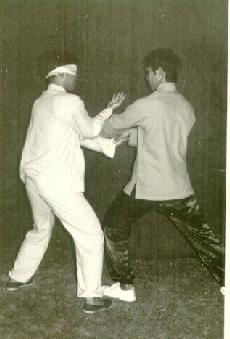
An old photograph taken more than 20 years ago showing Sifu Wong, being blind-folded, practising Wing Choon Chi Sau, or Sticking Hands, with Khor Koay Peng, a senior disciple of the late Sifu Choe Hoong Choy, the patriarch of the Choe Family Wing Choon Kungfu
Question 1
Sifu, your site is very profound and informative. It seems to me that you are greatly skilled at many forms of kung fu. However, I am very interested to know which styles you teach.
— Michael, USA
Answer
I teach Shaolin Kungfu. Occasionally I teach Taijiquan.
Some people may ask, quite rightly, what forms of Shaolin Kungfu I teach. I often find it hard to answer such a question because of the following reasons.
There are many forms of Shaolin, such as Lohan, Eagle Claw, Praying Mantis, Hoong Ka, Wing Choon and Choy-Li-Fatt. The first three forms were derived from Northern Shaolin, and the latter three from Southern Shaolin. The full terms of these kungfu forms or styles are Shaolin Lohan Kungfu, Shaolin Hoong Ka Kungfu, etc, but generally they are shortened to Lohan, Hoong Ka, etc.
They are called Shaolin styles because the first masters who developed these styles brought them out directly from the northern Shaolin Temple in Henan, or the southern Shaolin Temple in Fujian in China, or indirectly through earlier Shaolin masters.
For example, Yue Fei who developed Eagle Claw Kungfu, learned from Zhou Tong who learned at the northern Shaolin Temple. Hoong Hei Khoon who developed Hoong Ka Kungfu, learned from Chee Seen at the southern Shaolin Temple.
Because their development occurred at vastly different times and at different places, these Shaolin styles are characteristically different from one another, although they all came from Shaolin. Lohan Kungfu, for example, is characteristically different from Wing Choon, and Praying Mantis characteristically different from Choy-Li-Fatt.
While these Shaolin styles were practised outside the Shaolin Temples, kungfu was also practised in the two Shaolin Temples themselves. This kungfu practised in the temples was logically called Shaolin Kungfu.
Because the Shaolin Temples, especially the one in the north, have existed for a long time, the Shaolin Kungfu practised in the temple at one time, say the Song Dynasty, would be very different from the Shaolin Kungfu practised at another time, say the Qing Dynasty many hundred years later.
The Shaolin Kungfu I practise was from the Qing Dynasty at the time when the southern temple was burned. So when someone asks me what style of Shaolin Kungfu I practise, I could only say Shaolin Kungfu, and could not mention any style.
Perhaps, if the particular type of Shaolin Kungfu I teach becomes popular a few hundred years later, later generations may call it Wahnam Kungfu, to distinguish it from other types of Shaolin Kungfu — in the same way as people now call the type of Shaolin Kungfu popularized by Chen Herng as Choy-Li-Fatt, to distinguish it from other Shaolin types like Lohan or Wing Choon.
But personally I would prefer it to be called Shaolin Kungfu, although my school is called Shaolin Wahnam, in honour of my two masters, Sifu Lai Chin Wah and Sifu Ho Fatt Nam. Both my masters stressed that what they taught was Shaolin Kungfu, and not Chin Wah Kungfu or Fatt Nam Kungfu.
Question 2
Do you teach chin-na, although I have hear it is present in most kung fu forms?
Answer
Yes, chin-na is an important part of my kungfu teaching.
Although some chin-na is found in most kungfu forms, it is not a prominent part of them. The style that specializes in chin-na is Eagle Claw Kungfu, and it is also important in Hoong Ka Kungfu. But it is seldom used in Baguazhang, Xingyi Kungfu, Taijiquan, White Crane and Wing Choon.
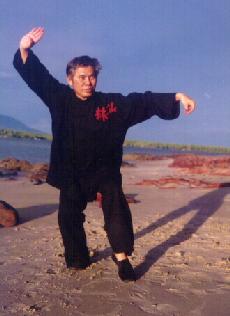
Chuaquan, which is Northern Shaolin, is from Southern Shaolin Kungfu
Question 3
You mentioned the five animal forms in a part of you web site. Do you teach all five or a selected few?
Answer
Sometimes I teach all five, sometimes I teach a selected few. When I teach the “Five-Animal Set”, I teach all five. When I teach the “Tiger-Crane Set” I teach a selected few.
But even when I intend to teach a selected few, the remaining “animals” would also show their presence, because these five “animals” are typical in Shaolin Kungfu.
Question 4
Do you teach pressure points? I say pressure points because I do not know the official name of the art.
Answer
Yes, to senior students. There is no official name, but the terms “vital points” and “energy points” are frequently used.
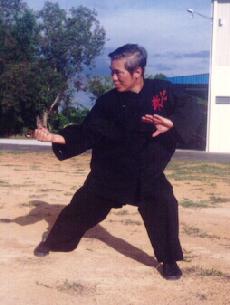
This pattern, “Lohan Strikes Drum”, which is from Southern Shaolin Kungfu, is quite different from a Northern Shaolin pattern
Question 5
I have heard that Shaolin masters can sense the movements of their opponents in darkness, or while they are blind folded. Is this true, and if so do you teach such methods?
Answer
Yes, it is true. Wing Choon students develop this skill in “Chi Sau” or “Sticking Hands”, and Taijiquan students in “Tui Sau” or “Pushing Hands”.
Yes, I teach these methods. Both “Chi Sau” and “Tui Sau” are fundamental skills, which means they are taught to all students. Whether the exponents could sense the movements of their opponents in darkness or while being blind folded, will depend on how well they have developed the skills.
In my Taijiquan classes a few days ago in Bamyoles in southern Spain, students did not practise in darkness or were they blinded folded, but some of them could neutralize their partners' attacks through sensing, and not through directly seeing the attacks.
Question 6
I have been suffering with my eyes for some 3 years now, partly from a condition known as kerititus (herpes simplex), which can cause redness, soreness, blurred vision and ulcers, which in turn can lead to permanent scarring on the eyes. The problem has been treated with western medicine (steroids), but these do not offer a permanent solution as the condition has a tendency to return. Also, long term treatment can lead to further problems.
Hence I would like to try another approach to healing, via “treating the patient rather than the problem” in the hope that my natural immune system can be adjusted to help me. I have decided that qigong might be my most favourable alternative.
— Paul. United Kingdom
Answer
You are right. You should use the approach of healing the patient rather than the problem. In this way, you will not only overcome your eye problem but also other problems if any. This is the approach of Chinese medicine.
There are many disciplines in traditional Chinese medicine, such as herbalism, acupuncture, massage therapy and qigong therapy. In these methods, the traditional Chinese medical doctor has to diagnose the causes of your problems.
If, for example, the causes of your problems are blockage of the colon meridian and too much “fire” at your eyes, he will remove the causes and then nourish you back to health, using the methods of his particular training, such as using herbs, acupuncture needles, massage or remedial chi kung exercise. As a traditional Chinese medical doctor is often trained in multi disciplines, though specialized in one, he may also use multi-disciplinary methods, like combining herbs with acupuncture.
If his diagnosis is accurate, you will recover as a matter of course. In Chinese medical philosophy there is no such a thing as an incurable disease. Hence, diagnosis is utmost important in Chinese medicine.
Nevertheless, even when a Chinese medical doctor is very careful, he may sometimes make mistakes in his diagnosis. Hence your may not recover as his prescribed treatment will not be appropriate.
This problem of wrong diagnosis does not exist if you practise qigong (chi kung) — as distinct from undergoing qigong therapy. This is because in qigong training, there is no need for diagnosis! This is a fantastic fact, and it has enabled me to help countless people overcome their so-called incurable diseases.
Many people, especially those used to western medical philosophy, may find this fact ridiculous. A brief explanation can make it clear.
Qigong, like Chinese medicine, works on a paradigm different from that of western medicine. The most important principle in Chinese medical philosophy, which qigong uses, is that yin-yang harmony results in good health. And the operational force that maintains yin-yang harmony is harmonious energy flow.
These two principles are actually very simple, so simple that many people, used to complicated ideas, do not pay attention to them. In western language, the two principles can be translated as follows. If the energy that works all your body systems, organs, muscles, tissues, cells, etc works harmoniously, you will be healthy.
“You will be healthy” means not only you will have no eye or other health problems, but also you will enjoy your daily work and play. And the forte of qigong is to promote harmonious energy flow.
Nevertheless you must practise not only genuine qigong, but also one that is of a high level. Even if the qigong you practise is genuine, if it is of a low level, it may not be powerful enough to help you attain the sort of harmonious energy flow you require. Much of what is available on the market today is gentle exercise, not genuine chi kung. High level genuine chi kung is rarer still.
Even if you practise high level qigong, it is not guaranteed that your eye problem will be over. In theory your eye and other problems should be overcome, but in practice there may be other factors negating the benefits of qigong.
For example, if you do not practise regularly or if you are constantly exposed to strong factors that cause your problems, you will be in a continued struggle between the benefits of qigong and the negative factors. In Chinese medical jargon, this is referred to as the battle of good and evil.
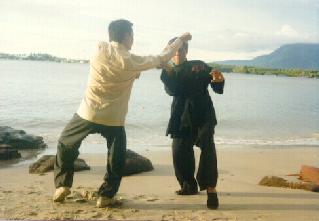
Sifu Wong and Goh Kok Hin employing the tiger and the crane forms in combat practice. Goh Kok Hin attacks Sifu Wong's left temple with a pattern called “Reincarnated Crane”, using his right crane beak to attack the opponent's vital point. This is using one's strong point against the opponent's weakness.
Question 7
I understand that there are hundreds, if not thousands of different types of qigong, and that if not supervised/performed correctly some of these can themselves lead to further health problems. I have read that “18 forms tai chi qigong” and “8 pieces of brocade” may be safe to practice, but if so which one (if any) might be "best" for me, or what other style might be more appropriate? I am also in the unfortunate geographical position of not having a teacher in my area,
Answer
“The 18 forms of Taiji Qignog” and “The Eight Pieces of Brocade” are popular qigong taught to the public. Such qigong is generally not powerful, because powerful qigong has to be taught personally, not in large groups. Qigong for large groups is usually of a low level so as to be safe. Hence these two types of qigong may not be suitable for your purpose.
Moreover you have to learn powerful qigong personally from a master. If there are no masters around your area, it is best for you to attend my Intensive Chi Kung Course in Malaysia, where you can learn very powerful qigong personally from me in just three days. You have to continue to practise on your own after you have returned home.
As mentioned earlier, there is no guarantee that your eye problem will definitely be cured as other factors are at work, but based on my records you would have more than 80 percent change of recovery.
Compared to other serious eye problems I have helped people to overcome, such as impending blindness, yours is actually a relatively minor problem. Once the blockage of energy flow to your eyes is cleared by vigorous qi flow which you will learn in my course, your problem would be overcome. You should have your problems solved after regular practice of a few months. What you aim to get from my course is not just overcoming your eye problem but attaining excellent health.
Question 8
I do not want to follow a wrong path through my own hastiness/ignorance and would therefore be extremely grateful if you could offer me any advice on this matter.
Answer
This is wise. Start well and get the best benefits. Don't be satisfied with mediocre qigong practice. But of course if you want to get the best, you have to pay the necessary price, in terms of effort as well as money. Otherwise you have to be contented with mediocre results.
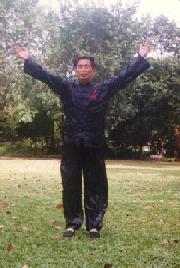
Quiescent chi kung, like the “Embracing the Sun” shown above where a practitioner remains stationary for some time to let cosmic energy flow into him, is very different from dynamic chi kung.
Question 9
I have visited all of your websites and I am very impressed. I have just started training in Northern Shaolin Kung-Fu. I wish to excel among my classmates. I am ready to train very hard, yet I am the least flexible and weakest of my peers.
— Diego, USA
Answer
To excel, it is not enough just to train hard. Training hard is essential, but equally important is to train smart.
A student who now attends my chi kung classes as well as Taijiquan classes, just told me that after attending my Taijiquan classes for only four days a few months ago, when he returned home to train with his class mates they were amazed at his tremendous improvement, and he honestly believed without being vain that he was better then them although they had trained for nine years and he had trained for only a year.
Another student, who has trained Shaolin Kungfu with me for a few years, told me he was simply amazed that when he sparred with a kungfu practitioner who had trained for more than 26 years, with much emphasis on free sparring, my student found both the force and the combat techniques of the other person so far behind his own.
Citing these examples is not meant for self-glorification, but is a sincere attempt to help dedicate students realize that if they train smartly they can avoid wasting a lot of time. Just a minute of reflection will make this clear.
Suppose you learn Taiji. You only perform the forms, but even at the physical level you do not know how to “differentiate yin-yang” and how to “move from the waist”. You do Pushing Hands occasionally, but have no idea about its significance and direction. And you have no experience at all of internal force. In such conditions, your Taiji standard after nine years of training is not much different from that after one year.
Now you learn smartly. You understand that Taijiquan is an internal martial art. Hence you ensure that your training is congruent with the meaning of the art. You develop internal force and learn combat application, otherwise what you train cannot be internal or martial.
In six months, even you may not have much internal force or be a good fighter yet, you will still be better than someone whose nine-year training has no purpose and direction. This someone has not trained for nine years; he has merely spent nine years repeating external Taiji forms, often together with common weaknesses like bad stances and poor balance.
Training smart includes knowing your objectives and ensuring that your training leads to your objectives. It also includes identifying your weaknesses and overcoming them.
If you know that you are not flexible and not strong, practise stretching exercises and chi kung to improve your flexiabilty and strength. If you have no access to chi kung exercise, then practise some suitable physical exercise, though this is a poor substitute.
Question 10
I am somewhat obese and I have sensitive skin that bruises easily. If you would be so kind, can you tell me where I can find out some toughening techniques and exercises or where your books are sold.
Answer
You should practise the appropriate remedial exercises to overcome your particular weaknesses, and not practise any exercises aimlessly. Only if you are soft, you need toughening, or if you are ignorant you need good books for enlightenment.
For example, if your bands are soft you may toughen them by punching a sandbag or a wall. But why do you want tough, rough hands? Tough, rough hands may not necessarily make you powerful or combat effective.
You may like to hear my personal story. Years ago I attempted Iron Palm training like some of my senior classmates under Sifu Ho Fatt Nam. Seeing my delicate hands, my sifu said, “Don't spoil those soft hands. You can be powerful without being tough and rough.” So he taught me Cosmos Palm. Now not only my Cosmos Palm is powerful and effective for combat, I have used it to relieve may people of illness, including some otherwise terminal diseases.
To overcome obesity and sensitive skin problem you have to practise genuine chi kung, which will also make your arms and hands powerful. And to practise genuine chi kung, you have to learn it from a master or at least a competent instructor. This is a requirement you have to fulfill if you are smart. Just as if you are smart, when you are sick you see a doctor, and when you have some legal issues to settle you see a lawyer. You will be foolish if you attempt to overcome your obesity, skin problem, sickness or legal issues from techniques described in an e-mail or a book.
Nevertheless, if you have no access to a genuine chi kung teacher, practising “Drawing the Moon” and “Lifting the Sky” from my book, “Chi Kung for Health and Vitality”, may help you to overcome your problems.
My books were originally published by Element Books. But Element Books is now out of business, despite the great demand for my books. Random House has brought over the rights to publish these books, and it will come out with these books soon. Please check up with your book shops, or on-line with Amazon.com or other on-line book-sellers.
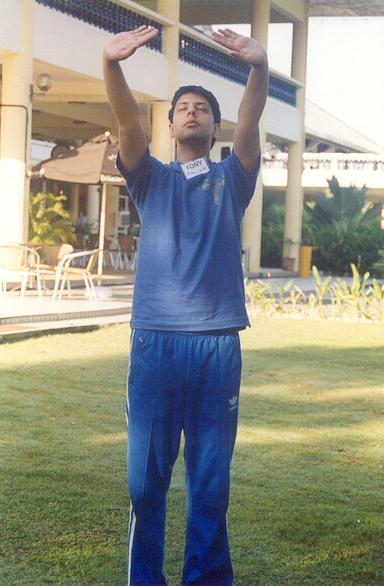
Dynamic chi kung, like “Lifting the Sky” shown above where physical movement is obvious, is different from quiescent chi kung.
Question 11
Someday, I would like to train under you but I would not be able to for about 7 years so I will continue my instruction under my sifu till I go to college. Right now I am 15 and in High School. I will be a sophomore. Any information you could give me would be very useful.
Answer
I would love to have a student like you. Although you are young you have direction. You realize your limitation of being unable to train with me now, and are willing to wait, and you have the fore-sight and patience to wait for 7 years.
Despite your young age, you are more matured in your thinking than many others who asked me not just to teach them in an intensive course but for many years without charging them any fees, and at the same time to house and feed them.
Continue your training with your present sifu, whom you must respect and honour. Use my book, “The Art of Shaolin Kung Ku”, as a guide. You can also practise some of the exercises described in the book. If you have any questions please feel free to contact me.
